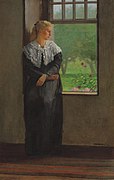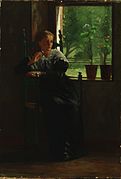
The Metropolitan Museum of Art, colloquially referred to as the Met, is an encyclopedic art museum in New York City. By floor area, it is the fourth-largest museum in the world and the largest art museum in the Americas. With 5.36 million visitors in 2023, it is the most-visited museum in the United States and the fifth-most visited art museum in the world.

Winslow Homer was an American landscape painter and illustrator, best known for his marine subjects. He is considered one of the foremost painters of 19th-century America and a preeminent figure in American art in general.

Howard Chandler Christy was an American artist and illustrator. Famous for the "Christy Girl" – a colorful and illustrious successor to the "Gibson Girl" – Christy is also widely known for his iconic WWI military recruitment and Liberty loan posters, along with his 1940 masterpiece titled, Scene at the Signing of the Constitution of the United States, which is installed along the east stairwell of the United States Capitol.

Carnegie Museums of Pittsburgh is a nonprofit organization that operates four museums in Pittsburgh, Pennsylvania, United States. The organization is headquartered in the Carnegie Institute and Library complex in the Oakland neighborhood of Pittsburgh. The Carnegie Institute complex, which includes the original museum, recital hall, and library, was added to the National Register of Historic Places on March 30, 1979.

Thomas Worthington Whittredge was an American artist of the Hudson River School. Whittredge was a highly regarded artist of his time, and was friends with several leading Hudson River School artists including Albert Bierstadt and Sanford Robinson Gifford. He traveled widely and excelled at landscape painting, many examples of which are now in major museums. He served as president of the National Academy of Design from 1874 to 1875 and was a member of the selection committees for the 1876 Philadelphia Centennial Exposition and the 1878 Paris Exposition, both important venues for artists of the day.
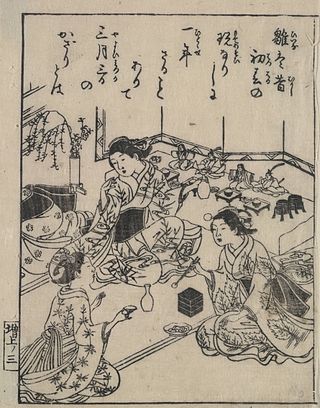
Nishikawa Sukenobu, often called simply "Sukenobu", was a Japanese printmaker from Kyoto. He was unusual for an ukiyo-e artist, as he was based in the imperial capital of Kyoto. He did prints of actors, but gained note for his works concerning women. His Hyakunin joro shinasadame, in two volumes published in 1723, depicted women of all classes, from the empress to prostitutes, and received favorable results.

The Gulf Stream is an 1899 oil painting by the American artist Winslow Homer. It shows a man in a small dismasted rudderless fishing boat struggling against the storm-tossed waves and perils of the sea, presumably near the Gulf Stream, and was the artist's statement on a theme that had interested him for more than a decade. During the time he explored this theme, Homer, a New Englander, boated often near Florida, Cuba, and the Caribbean.
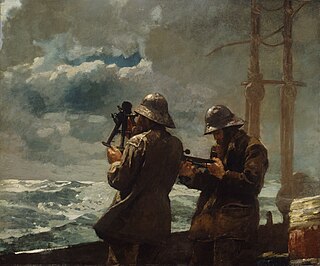
Eight Bells is an 1886 oil painting by the American artist Winslow Homer. It depicts two sailors determining their ship's latitude. It is one of Homer's best-known paintings and the last of his major paintings of the 1880s that dramatically chronicle man's relationship to the ocean.
Lloyd Goodrich was an American art historian. He wrote extensively on American artists, including Edward Hopper, Thomas Eakins, Winslow Homer, Raphael Soyer and Reginald Marsh. He was associated with the Whitney Museum of American Art in New York City for many years.

The Fox Hunt is an 1893 oil on canvas painting by the American artist Winslow Homer. It depicts a fox running in deep snow, menaced by hungry crows. His largest single work, it has been described as "Homer's greatest Darwinian painting, arguably his greatest painting of any kind."

The Boat Builders is an oil painting on panel executed in 1873 by American landscape painter Winslow Homer. It is held in the collection of the Indianapolis Museum of Art (IMA), in Indianapolis, Indiana, United States.

A Visit from the Old Mistress is an 1876 painting by the American artist Winslow Homer. It was one of several works that Homer is thought to have created during a mid-1870s visit to Virginia, where he had served for a time as a Union war correspondent during the American Civil War. Scholars have noted that the painting's composition is taken from Homer's earlier painting Prisoners from the Front, which depicts a group of captive Confederate soldiers defiantly regarding a Union officer. Put on display in the northern states for a northern audience, A Visit from the Old Mistress, along with Homer's other paintings of black southern life from the Reconstruction era, has been praised as an "invaluable record of an important segment of life in Virginia during the Reconstruction."
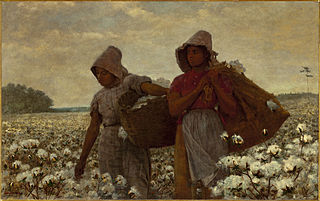
The Cotton Pickers is an 1876 oil painting by the American artist Winslow Homer. It depicts two young African-American women in a cotton field.
Stately, silent and with barely a flicker of sadness on their faces, the two black women in the painting are unmistakable in their disillusionment: they picked cotton before the war and they are still picking cotton afterward.

The Fog Warning is one of several paintings on marine subjects by the late-19th-century American painter Winslow Homer (1836–1910). Together with The Herring Net and Breezing Up, painted the same year and also depicting the hard lives of fishermen in Maine, it is considered among his best works on such topics.
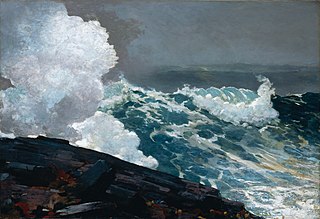
Northeaster is one of several paintings on marine subjects by the late-19th-century American painter Winslow Homer. Like The Fog Warning and Breezing Up, he created it during his time in Maine. It is on display in the Metropolitan Museum of Art in New York. Viewers are presented a struggle of elements between the sea and the rocky shore. Winslow Homer excelled in painting landscape paintings that depicted seascapes and mountain scenery.

Moonlight, Wood Island Light is a late 19th-century oil painting by American artist Winslow Homer. The painting is in the collection of the Metropolitan Museum of Art in New York.

Sarah Helena de Kay Gilder was an American painter, illustrator, and cultural tastemaker from New York City.
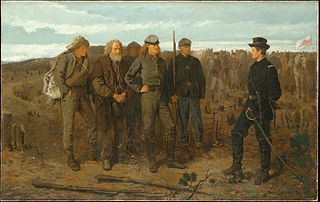
Prisoners from the Front is an 1866 painting by American artist Winslow Homer. One of Homer's most notable early works, the painting depicts a scene in which Confederate officers surrender to Union Brigadier General Francis Channing Barlow during the American Civil War. Homer's experience as a war correspondent likely contributed to his rendering of the work.



